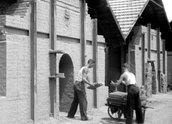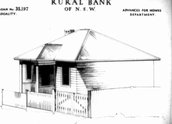

Home (c.1936)
Synopsis
Dedicated to ‘home builders and home lovers everywhere’, and presented by the Rural Bank of New South Wales, Home looks at the changing landscape in home building over the years, from the first settlers to modern home owners, and the desire to have a place to call home. It looks at the industries dependent on the housing industry, including the logging industry, and steel and brick manufacturing. In the end, it is these industries that provide employment, prosperity and the fulfilment of people’s desire – to have a place to call home.
Curator’s notes
Home is framed as a story of progress and development, as told by a building and contract officer (presumably of the Rural Bank of New South Wales) to two young potential home builders. His story starts with construction of shelter in the early days of white settlement, the prelude to the ‘young and virile nation’ that Australia has become. The ‘urge to build’ or ‘raise a roof over our head’ as the officer says, is a basic human desire stretching back to the earliest times, although the methods of building have greatly changed. The couple (and the audience) are told that nowadays building a home is much easier, as industrially produced construction materials are available to the builders. They are told about some of the industries dependent on the housing industry including logging, steel, brick and tile manufacturing. These industries not only provide employment for homebuilders, but prosperity for the whole country.
The emphasis on home as a place of both shelter and as the fulfilment of a desire provides the link in this promotional documentary for the Rural Bank between the past, present and future. Subtly underscoring this story of building, nationhood and progress is the promise that it will be the Rural Bank of New South Wales who can provide the financial support to make this dream a reality – for both home lovers and home builders alike.
The Rural Bank of New South Wales also made Conquest (1936) and Mother Earth (1938) which were targeted at farmers, pastoralists and the agricultural sector in the region. In these advertisements, the bank positioned itself as not only a friend to the man on the land, but a bank that understood his needs and appreciated his struggle. Similarly here, the struggles and desires of home builders and the workers in the industries that support them are given a sympathetic and understanding ear by the bank that understands them the most.
- Overview
- Curator’s notes
- Video 2 clips

- Principal credits
- Find a copy
- Make a comment
- Add your review



